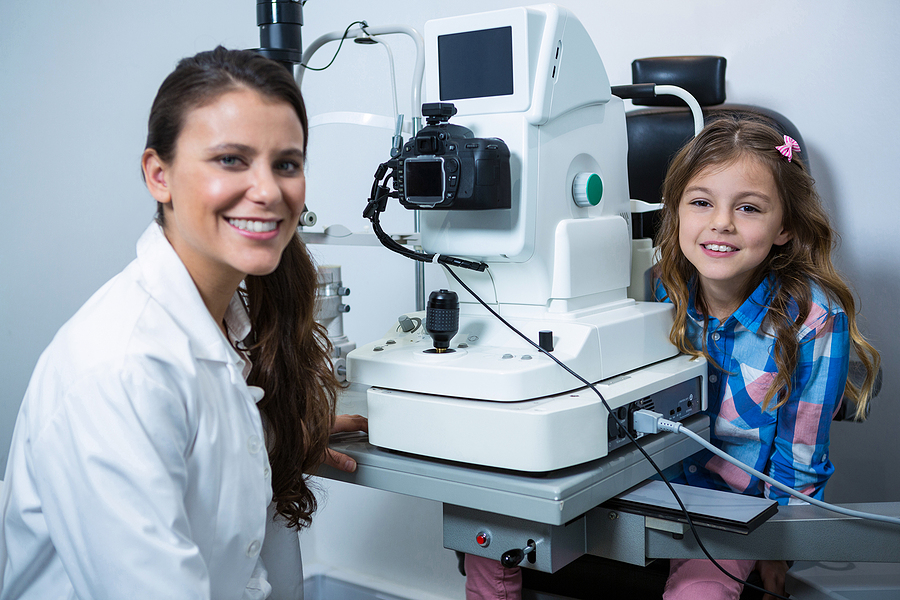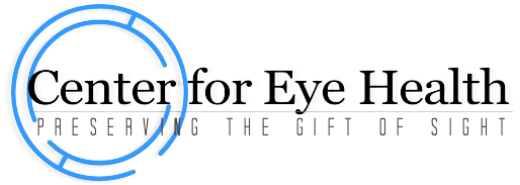Eye Examination for Children
Children are examined for any rare congenital problems at birth and at each well-child examination by the primary care physician, who will check for problems that may not be apparent to the parent or child but that could have serious consequences for the child’s vision. When the child is old enough, the primary care physician will perform a more formal vision screening examination. If the parent or the child’s doctor has any concerns, or if there is a family history of strabismus, amblyopia, or other eye conditions, the child should be referred to an ophthalmologist The Center for Eye Health for evaluation.

Conditions that the primary care physician will screen for include:
* strabismus (misaligned eyes);
* amblyopia (lazy eye);
* ptosis (drooping of the upper eyelid); and
* decreased vision.
If the child is referred to an ophthalmologist, he or she will conduct a physical examination of the eyes, using eye chart tests, pictures, or letters to test the child’s ability to see form and detail of objects, and to assess for any refractive error (nearsightedness, farsightedness, and astigmatism).
Vision problems in children can be serious, but if caught in time and treated early, the child’s good vision can be protected.
Strabismus
Strabismus is a condition in which the eyes are not aligned and point in different directions. This condition affects about 4% of adults.
Strabismus may begin in childhood and persist, reoccur, or become symptomatic in adulthood. Strabismus also can result from certain medical problems. Graves’ disease (thyroid eye disease), diabetes, strokes, and trauma are some of the more common conditions that can lead to strabismus. Less common causes are diseases that affect the muscles such as myasthenia gravis, demyelinating diseases such as multiple sclerosis, or brain and orbit tumors. Occasionally strabismus can develop after eye surgery, such as cataract, retinal, or glaucoma surgery.
Adults with strabismus may have double vision, loss of depth perception, confusion between images, eye fatigue, and reading difficulty. They often experience psychological or social problems because of the condition, and they may have problems interacting with others or securing employment because of the appearance of their eyes.
Strabismus can be treated at any age. Occasionally, eye muscle exercises, prism eyeglasses, or botulinum toxin injections can improve certain types of strabismus if the misalignment is slight. Often surgery is required. Surgery is done on an outpatient basis and sometimes can be performed with a local anesthetic only. Strabismus surgery involves loosening, tightening, or repositioning the muscles to align the eyes. An adjustable suture may be used to fine-tune the end result. An ophthalmologist at The Center for Eye Health can recommend treatment options.
Babies’ Vision
Babies have poor vision at birth but can see faces at close range, even in the newborn nursery. At about 6 weeks of age, a baby should be able to fixate on an object (such as a face) and maintain eye contact. Over a child’s first few years, vision develops rapidly; 20/20 vision can be recorded by 2 or 3 years of age with some techniques.
Parents should be aware of signals of poor vision. If one eye “turns” or “crosses,” that eye may not see as well as the other eye. If the child is not interested in faces or age-appropriate toys, or if the eyes rove around or jiggle (called nystagmus), you should suspect poor vision. Other signs to watch for are tilting the head and squinting. Babies and toddlers compensate for poor vision rather than complain about it.
Should a baby need eyeglasses, the prescription can be determined fairly accurately by dilating the pupil and analyzing the light reflected through the pupil from the back of the eye.
A baby’s vision can also be tested in a research laboratory, where the brainwaves are recorded as the child looks at patterns of stripes or checks on a television screen. This is called a visually evoked potential (VEP) test. Another test, called preferential looking or Teller acuity cards, uses simple, striped cards to attract the child’s attention. In both tests, as the stripes grow smaller and closer together, they become more difficult to see, and the child’s level of visual acuity can be assessed.
Congenital Ptosis
Ptosis is a condition in which the upper eyelid falls to a position that is lower than normal. The drooping eyelid can cover part or all of the pupil and interfere with vision, resulting in amblyopia. Ptosis can affect one eye or both eyes.
Ptosis may be present at birth or develop later in life. If a droopy eyelid is present at birth or within the first year of life, the condition is called congenital ptosis. In most cases of moderate or severe congenital ptosis, surgery is required to tighten the eyelid muscles or suspend the eyelid from the brow so that the eyelid is not covering the line of sight. If the ptosis is severe, surgery may be recommended in infancy. Often surgery is delayed until a child is 3 or 4 years old.
Amblyopia, or “lazy eye,” is decreased vision in one or both eyes caused by lack of use. This condition can occur with congenital ptosis. If amblyopia is present, treatment with patching, eyeglasses, or eyedrops may also be necessary. If left untreated, amblyopia may lead to permanent vision loss.
Esotropia
One common form of strabismus, or misaligned eyes, is called esotropia. Esotropia, or “crossed” eyes, occurs when the eyes turn inward. Esotropia can be both congenital, when it occurs in infants, and accommodative, which is more likely to develop after two years of age.
Young children with congenital esotropia cannot use their eyes together. In most cases, early surgery can align the eyes.
With accommodative esotropia, when the child focuses the eyes to see clearly, the eyes turn inward. This “crossing” may occur when focusing at a distance, at close range, or both. Eyeglasses reduce the focusing effort and often straighten the eyes. Sometimes bifocals are needed for close work. If significant crossing of the eyes persists with glasses, surgery may be required.
The main sign of esotropia is an eye that is not straight. Sometimes children will squint one eye in bright sunlight or tilt their head in order to use their eyes together.

